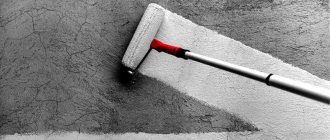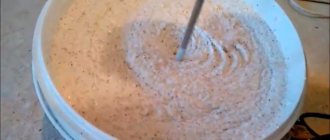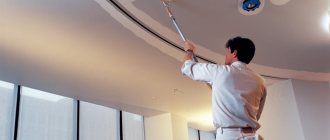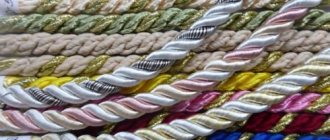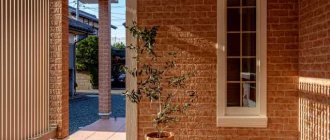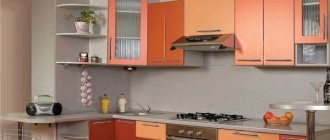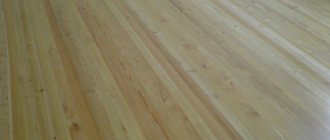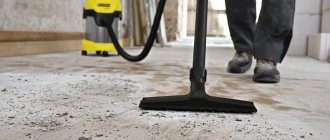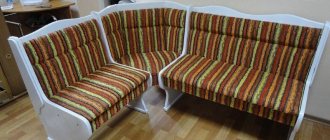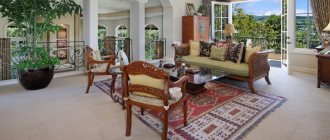Description and features of facade paint on plaster for exterior work
When purchasing paint for finishing a plastered facade, it is very important to pay attention to its characteristics, which will subsequently provide a sufficient level of resistance to atmospheric influences and at the same time will retain its properties, regardless of the influence of air temperature, wind gusts and humidity levels.
Performance characteristics
This characteristic is responsible for the immediate durability of the paintwork.
In this regard, materials are divided into two types:
- weatherproof;
- limitedly stable.
IMPORTANT!
For painting the facade, only the first option is suitable , because... Only with its help can you achieve the desired result regarding the protection of the surface of the house.
Weather-resistant paints are characterized by vapor permeability for walls that are treated with plaster. Thanks to this property, after condensation appears on the surface of the facade, it evaporates after some time and does not accumulate under the coating. After all, the accumulation of condensation promises the appearance of bulges on the walls and subsequently leads to the destruction of the coating.
This property is checked after applying a layer of paint and is characterized by the sponginess of the material. This parameter depends on the type of binder that is present in the paint coating.
In addition to vapor permeability, a very important indicator is resistance to UV rays , which are the most susceptible to destruction of the façade paint layer. In addition, resistance to sun rays ensures long-term color retention and the paint always looks like it was freshly applied.
Facade painting
The adhesion characteristic should not be neglected ; it ensures reliable bonding of the paint and plaster structure on the facade. If the paint has a high adhesion index, then it can prevent the appearance of blisters and bulges. However, not only the properties of the material itself ensure good adhesion, but also the correct process of preparing the wall surface before painting.
Another characteristic is water repellency . This property provides protection to the facade from the appearance and development of fungi, moss and bacteria. Such paints and varnishes repel water, preventing it from being absorbed into the wall surface.
The last performance characteristic that is worth paying attention to is increased resistance to mechanical damage . It lies in the fact that after applying and completely drying the paint, the material is not subject to destruction, for example, it does not scratch or crumble.
Ease of application
Convenience of applying paint and varnish is an important factor in this process . The technology of painting facades on plaster requires the thinnest possible layer when applying the material.
This is explained by the fact that a thick layer of paint chips off very quickly.
The paint must have a property that will not allow it to be absorbed into the wall surface when applied.
Also, this characteristic provides significant savings in the process of finishing the house . Additionally, such paints are convenient during application in that they do not form smudges or drops.
NOTE!
Considering that paint and varnish coatings acquire all their protective properties after complete drying, it must have a high drying speed . This property allows painting to be carried out in any weather conditions, even in late autumn.
Decorative characteristics
This characteristic is important, because the painted facade provides beauty to the entire building. There will be no questions with this characteristic if you select paint with the high characteristics described. This is explained by the fact that the color properties of paint directly depend on its durability.
Correctly selected paint should not change its color during application, nor after some time.
Regarding the texture of paints, they are:
- matte;
- glossy;
- semi-gloss.
Variety of colors
The most suitable paints for painting plastered facades are matte paints. They are able to hide any defects that are present on the plastered surface.
The best paints for exterior metal work
The paint protects the metal surface from atmospheric precipitation, prevents corrosion and increases the service life of the product.
Hammerite for metal surfaces
5
★★★★★
editorial assessment
97%
buyers recommend this product
Hammerite Alkyd Gloss Metal Paint provides a smooth, weather-resistant finish. The 3 in 1 formula replaces the primer, corrosion inhibitor and decorative finish. Proprietary technology with the addition of wax and anti-corrosion additives provides double protection against rust for 12 years.
The composition is sold in 14 ready-made shades in buckets ranging from 250 ml to 20 liters. A liter is enough to paint 10 m2. You can reapply the paint after 4-6 hours.
Pros:
- wide palette of ready-made colors;
- long service life of the coating;
- no need to prime or clean the surface;
- reliable protection against corrosion.
Minuses:
- the price is above average (from 500 rubles per 1 liter).
Before application, it is recommended to remove loose rust with coarse sandpaper or a wire brush. Then you need to clean the surface with detergent and let it dry. Hammerite paint is then applied directly to the corroded metal.
Teknos Futura 90
4.9
★★★★★
editorial assessment
96%
buyers recommend this product
Finnish paint Teknos Futura has a urethane-alkyd base. The composition forms a wear-resistant coating with a glossy shine. It is applied for finishing painting of primed metal or wooden surfaces located indoors or outdoors.
The composition is suitable for painting with a brush, roller or spray. The jelly-like consistency must be thoroughly mixed and applied only to a dry, clean surface.
Excellent painting properties are evident when applied with a brush. The paint quickly levels out and leaves no drips or streaks even on vertical surfaces. The coating takes a long time to dry. It will take at least 4 hours to dry to touch. The next layer can be applied only after a day.
The product is available in cans ranging from 0.45 to 9 liters. The manufacturer offers a tinting card of 382 colors. The ten most popular shades are sold ready-made. To create a dense protective coating, 2-3 layers are enough.
Pros:
- high wear resistance;
- can be applied in various ways;
- good hiding power;
- wide palette of colors.
Minuses:
- takes a long time to dry.
To increase the service life of the coating, it is recommended to prime metal surfaces with Ferrex anti-corrosion paint before applying paint.
Pro Siding
4.9
★★★★★
editorial assessment
93%
buyers recommend this product
Specialized paint Pro Siding has good adhesion to metal, vinyl, and polymer surfaces. The composition forms a highly elastic film, which is resistant to wet abrasion and temperature changes. The paint will not crack, fade, bulge or peel.
Antistatic additives allow the coating not to attract dust and other contaminants. The addition of glass-ceramic filler makes it resistant to intensive washing.
Paint consumption is minimal: one liter is enough for 12-15 m2 when applied in one layer. If you need to change the color dramatically, you will need 2 layers. The composition dries quickly - half an hour is enough for it to come off. The surface can be re-coated after 4-6 hours.
Pros:
- contains antistatic agent;
- economical consumption;
- dries quickly;
- high elasticity;
- good wear resistance.
Minuses:
- demanding on application conditions.
It is better not to apply paint in cold weather or in direct sunlight - its adhesion to the surface in these cases deteriorates. It is recommended to take into account the movement of the sun relative to the object and paint from the shadow side.
Panzer Enamel hammer paint
4.8
★★★★★
editorial assessment
88%
buyers recommend this product
Panzer's one-component hammer-effect paint has good adhesion to rusty surfaces. It forms an impact-resistant and abrasion-resistant coating, the service life of which is on average 5 years. The composition is safe and does not contain toluene or lead.
The paint is easy to apply. One coat is enough to update the shade. If you need to change the color, you can reapply it after 2 hours. Complete drying occurs within 6 hours. The composition is available in 9 ready-made shades in metal cans with a volume of 0.25-2.3 liters.
Pros:
- economical consumption;
- composition without volatile organic compounds and heavy metals;
- convenient packaging;
- dries quickly;
- forms an impact-resistant wear-resistant coating.
Minuses:
- strong smell;
- not sold everywhere.
When painting indoors, you need to ensure good ventilation, otherwise it may have a bad effect on your well-being. Still, the composition is not universal, so it is better not to experiment.
READ ALSO
13 best ceiling paints
Is coloring necessary?
Many people wonder about the need to paint a plastered surface. This question can be answered by taking a closer look at the benefits that such an event provides.
The first and most important property that painting facades provides is its protective function.
Plaster is a fairly vulnerable coating that can allow moisture to pass through and accumulate condensation; it is destroyed by mechanical stress or after prolonged exposure to sunlight.
If mechanical damage or any other destruction is fairly easily restored, then the lack of properties such as permeability and water repellency can cause significant damage to the walls of the house. The accumulation of condensation provokes not only the formation of mold and mildew, but also the destruction and rotting of the materials that are in the “pie” of the wall.
If you apply paint to the surface of the façade that meets a high level of the specified characteristics, then many problems can be avoided. An additional advantage of using paint is the ability to create any of the design solutions.
What to paint with?
To summarize all that has been said, we note that for a beautiful facade made of decorative plaster, the choice should be made on one of the water-dispersion (water-based) paints: acrylic, latex, silicone or silicate.
It is difficult to make any rating here. Firstly, manufacturers have different color catalogs, and it’s a matter of taste which paint will be best for you. Secondly, the characteristics of materials vary depending on the additives. Accordingly, the price will also vary.
The cost starts from 180 rubles per 1 liter and up to 600-700 rubles/l. By the way, paint and varnish materials can have a high price not only because of their good quality, but also because they were brought from another country. For example, the popular Tikkurila is produced in Finland. Therefore, to save money, you can choose good paints from Russian manufacturers, for example Tex, Lakra, etc.
The video provides additional recommendations for choosing facade paint.
Having chosen what to paint the facade of the house with, let’s look at how to do it
Types of paints
How to paint the facade of a private house? There are several types of paints intended for facade finishing:
- Silicate . The paint is based on liquid glass, which is otherwise called silicate glue , as well as various mineral pigments and silicate-type filler. This composition is capable of providing durability, complete resistance to precipitation, even acidic types, and is rightfully the best option . On average, this type of paint can last more than 20 years. Has a high level of vapor permeability. Its only disadvantage is the lack of sufficient elasticity, which leads to the formation of cracks, and after thermal expansion of the plastered surface, marks remain on the paint.
- Limestone . Slaked lime is used as the basis for the production of this type of paint . This paint is washed off by precipitation and gets very dirty. Its advantages include a high level of vapor permeability and immunity to the appearance of fungus . Regarding the variety of colors to choose from, it is very limited and is represented only by pastel tones.
- Cement . The cement variety of paint has all the features inherent in the lime variety, but has a higher level of resistance to moisture and precipitation . In addition, it lacks a bactericidal effect, which allows fungi to form.
- Acrylic . The composition of this type of paint is based on acrylic resins . It has a sufficient level of vapor permeability, but it is significantly lower than that of the silicate variety. It is characterized by low hygroscopicity , but high abrasion resistance.
- Silicone . This type of paint coating is considered the most worthy option for painting a plastered facade. Thanks to it, the facade acquires hydrophobic properties , any precipitation and condensation flows down the walls without accumulating on the surface. The silicone variety allows for free diffusion. Adheses well to any type of surface, is resistant to prolonged exposure to sunlight and various adverse weather conditions. The paint surface is unable to become electrified , which ensures that dust is repelled and the surface of the facade does not become dirty so quickly.
Specifications
You can choose the most suitable option, taking into account all the nuances regarding the climate of the area in which the house is located, the type of plaster and other parameters. But, as mentioned above, for private construction the silicone type of paint is considered the most suitable, because... it provides complete protection from negative influences and looks aesthetically pleasing.
Main types and consumption of paints
Manufacturers of building materials offer a wide range of paints suitable for plastered surfaces.
Acrylic
Acrylic is the most versatile and budget option for emulsion paints. The adhesive components are polymer compounds. The finished layer has a strong and reliable structure. The product withstands various atmospheric conditions. An additional advantage of acrylates is that bacteria do not multiply in them, and therefore mold does not form on the surface.
Acrylic emulsions are divided depending on the water-dispersed or organic substances included in the composition. Excellent adhesion qualities are combined with various surfaces. Construction paints based on organic bases do not freeze at sub-zero temperatures. For this reason, they are used in the snowy Russian winter. It is allowed to process surfaces at a temperature of -15 degrees Celsius. The consumption calculation is 150-160 ml per m2.
Silicone
A silicone-based product will create a tinting and polishing effect. The component includes “liquid glass” and additional products that provide stunning external characteristics. The viscous penetrating substance fills the structure down to the smallest cracks.
By creating additional insulation, the protective layer protects the surface from the influence of destructive factors. The weather-resistant emulsion is capable of transmitting oxygen, which has a beneficial effect on the comfortable atmosphere in the room. Consumption per m2 is 140 -150 milliliters. Price per m2 - in two layers from 92.5 rubles.
Silicate
The compositions are characterized by low consumption of consumables, which is equal to 100-110 milliliters per square meter. High adhesion rates; with this characteristic, it should be taken into account that it will be difficult to remove silicate paint from the surface. If you plan to change the color of the facade over time, it is recommended to choose a different type of paint. Walls painted with a silicate look will retain their textured look for decades.
Cement
The paints have excellent moisture-resistant characteristics and are easy to apply. The product is intended for lime-cement surfaces. When working with cement or silicate-ash products, they should be diluted. Otherwise, the dyeing process will be difficult due to increased viscosity. The main disadvantage is the large consumption indicators - 200 ml per 1 m2.
Limestone
Paints for exterior use are available in a wide range; solutions and pastes are also available. This type does not contain polymer compounds and resins. The composition contains antimicrobial substances that prevent the formation of mold on the walls. The product is not economical in consumption - 180 ml. per 1 sq.m.
Oily
They are popular among consumers. Paints have a wide selection of colors. The positive quality of the material is low consumption of 100-130 grams per 1 m2. A liter jar is enough to treat 10 meters of surface. Consumption rates are affected by the required color saturation and how many balls of coloring matter will be applied. According to production technology, the paint recipe includes drying oil and mineral flour. There is no need to dilute the paint when using it. It is recommended to stir the product before use.
Wall preparation stage
Painting the facade begins with the process of preparing the surface of the walls. At this stage, further good adhesion of the paint and varnish coating of the wall is ensured.
First of all, when intending to paint the facade, you need to select the right weather conditions for this . You should choose a day on which rain, strong winds or temperatures below + 5 degrees are not forecast.
The process of preparing the walls is as follows:
- Initially, it is necessary to remove the layer of paint that is present on the facade (if there is one). It all depends on the type of paint and its condition. If oil enamel was used for painting, then it is necessary to clean the entire surface of the wall. The easiest way to do this is with a hair dryer and a hard spatula. If the acrylic variety was used, then it is allowed to apply acrylic water-based paint on top.
- Next, you need to assess the condition of the plastered surface . A wall that is ready for further painting must be leveled, but not get dirty, and when in contact with it, do not leave dust on your hands or crumble. It is recommended that if the above criteria are not met, the façade should be puttied.
- Applying a primer is a good way to add strength to the plastered surface and improve adhesion between the paint and the wall. The soil for such work is selected as a penetrating type.
Facade cleaning
Priming the wall
Kinds
There is a large variety of paint and varnish materials that are suitable for any type of surface. They are divided into:
- Oil-based: have a thick consistency and are easy to apply to any type of surface.
- Water-soluble: require mandatory dilution with water or other special means. Paints of this type allow the user to create a consistency that is convenient for use.
- Mineral: are natural minerals processed to a powder state. Widely used in exterior and interior finishing works of buildings. They dry quickly and last reliably for about seven years.
- Enamel: are unique paint coatings because they are suitable for working with any type of coating. They are resistant to light, water and negative environmental factors. Complete drying time ranges from 30 to 70 hours.
Each of these types has positive and negative properties. When choosing a certain type of paint, be sure to pay attention to the manufacturer.
Facade painting technology
To carry out painting, use a pneumatic or electric spray gun, a roller (medium-length pile) or a wide brush. Naturally, you will need to build scaffolding to provide access to the top of the house.
The painting process is as follows (photo below):
- First of all, the paint is thoroughly stirred using a mixer.
- It is most convenient to apply paint using a spray gun , however, if such equipment is not available and a brush or roller is used for painting, then paint is applied using strokes. It is recommended to apply strokes in different directions: vertically, horizontally and diagonally. Despite this unique method of painting, it is able to ensure the maximum degree of uniformity of the future coating.
- All types of facade paints require a two-layer application . The lime variety is applied in 3 layers.
- The dyeing process should not have too long pauses. The paint, after it begins to dry, subsequently creates a visible boundary between the part of the wall that was painted earlier and, accordingly, later.
- Applying layers should be carried out only after the previous one has completely dried.
- After painting, the walls are protected from dust particles and precipitation. To do this, cover them with plastic wrap.
Sectional view of the device
Spray painting
Roller painting
Varieties
Correctly chosen paint for plaster will provide the desired effect for a long time. There are several types of compositions that can be used for both interior walls and facades.
Water based emulsion paint
Indoor walls are often painted using a water-based PVA-based paint. This emulsion cannot boast of a richness of shades, but the situation can be corrected with the help of coloring colors. The composition is very easy to apply, it does not contain toxic components that can be released into the environment, and it is economical. It can be used on any surface. It dries quickly.
You should not use water-based emulsion to paint surfaces in rooms with high humidity. It quickly absorbs moisture. In order for the base to be rich in color, the composition is applied in several layers. To improve the adhesion of paint to the surface, the wall is pre-primed.
Acrylic washable paint
Painting plastered walls is done with an acrylic compound if there is a high level of humidity in the room. The characteristics of the material are as follows:
- Good reaction to evaporation, so the surface can be wiped with a damp cloth, while the decorative layer does not change its attractiveness;
- It is possible to change the color using a tint, so you can use acrylic paint when decorating any interior;
- The surface after applying the composition remains matte;
- The material is affordable;
- strength;
- ease of application;
- durability.
If water gets on the treated walls, then this type of paint should not be used.
Silicate paint
This paint for walls on plaster contains liquid glass, fillers and natural coloring pigments. If the technology was followed when applying the substance to the surface, the layer will last at least 10-15 years. It is vapor permeable and resistant to sunlight. Fungus or mold does not form on a wall with such a coating.
The disadvantage of this material is poor adhesion to organic-based surfaces. Its elasticity is not very good, so cracks often appear on the finish. When exposed to heat, the coating may become deformed.
Silicone paint
Silicone paint is suitable for plastered walls. It is intended for facade work. The surface acquires hydrophobic properties and retains vapor permeability. A favorable indoor climate is maintained.
In addition to facade paints, there are silicone paints for interior work.
Alkyd and oil paint
Oil and alkyd compositions have a rich color. Once applied, they create a durable layer. But when working with them you need to use protection. The substances have a strong unpleasant odor that remains until the layer dries. The disadvantage is their high consumption and low speed of work. However, such a coating can last for a long time without requiring special care.
Wall paint for plaster
At least 2 months should pass from plastering the wall with cement mixture to painting it. This is due to the fact that plastered walls can shrink when they dry out.
Interior work
For the nursery, choose the safest paint. But since children can make drawings on the walls, choose a composition so that the wall can be easily washed afterwards.
In the bedroom and living room you can use matte paints in pastel colors. For the bathroom and kitchen, the main requirement is water resistance.
Remember that when painting interior walls, it is better to keep the room ventilated.
Exterior works
For exterior work, you should choose the most wear-resistant paint. One that is not afraid of temperature changes and high humidity.
Stages of painting plastered walls
If you know nothing about how to paint plaster walls, have never encountered this job before, and are just beginning to learn the secrets that builders use, then you are in the right place. Now we will describe all the steps that make up a practical guide to painting plastered walls.
Preparation
Many construction and renovation processes begin from this stage. Our case was no exception; it is imperative to prepare plastered walls for painting. Its essence is to cover up cracks, chips and other minor defects. For this, putty or a mixture of cement and sand can be used. There should be no debris or dust on the surface; you need to make the surface as clean as possible.
The work is not completed here, so we continue to tell you how to prepare plastered walls for painting. Preparatory work concerns not only the working surface, but also neighboring areas. The floor must be covered with film, and with it all objects that are located in the workroom. The perimeter of the ceiling must be covered with masking tape.
Primer
Primer of plastered walls before painting is mandatory. This stage should not be ignored under any circumstances. Using a primer will reduce paint consumption and ensure high adhesion between the wall and the paint. Any acrylic material can be safely chosen for wall treatment. In stores there is concentrated soil that needs to be diluted in water. You cannot deviate from the manufacturer’s proportions and recommendations.
The primed surface is left to dry. You cannot apply paint to a wet wall.
Preparing the paint
Not all painting materials are sold ready-made. For example, alkyd and oil-based materials must be prepared for application - diluted with a solvent to achieve the required thickness. Water-based paint requires working with color. This process is not difficult, but will require time and patience. You need to add the required number of tubes to the paint container. The resulting mixture is thoroughly mixed, a small amount of paint is applied to the wall, and its shade is assessed after drying.
Apply paint
And now, finally, we can start painting the surface. The tools that are involved in this process have been described above. The easiest way to work is with a spray bottle. But it is most often used for work in industrial premises.
A roller is a more common version of the tool. The roller makes vertical movements. To achieve uniformity of coloring, it is necessary to monitor the edges of the roller. It is in these places that a large amount of paint accumulates. If it is not removed, then stripes with a more saturated color will be present on the surface.
This concludes our conversation. Today you learned a lot of useful information: how to treat plastered walls before painting, what paint to choose, what tool to choose, etc. Even if you don’t do this work yourself, you will be able to professionally supervise the hired workers.
